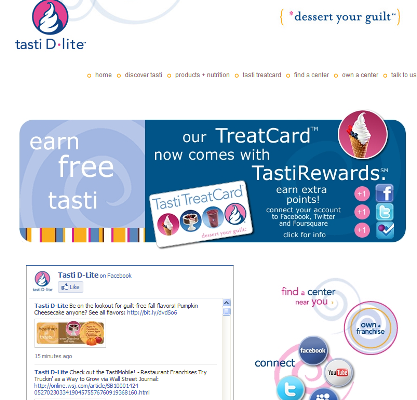Businesses are integrating location-based services such as Foursquare, Gowalla, Loopt and Socialight into enterprise applications.
For example, ice cream retailer Tasti D-Lite incorporated Foursquare into its loyalty program, providing extra reward points for customers who check in at a store using the application.
Why you care — Individuals increasingly use smartphones to access social media and use location-based services to tell their friends where they are. “We saw that our customers were already using these applications, so we wanted to put a mechanism in place that would reward them for their digital activity related to Tasti D-Lite,” says B.J. Emerson, the retailer’s social technology officer. He attributes a recent 36 per cent bump in sales in part to Foursquare activity. It’s a way, he says, to extend the experience of visiting a Tasti D-Lite store to the online world and encourage more discussion about its products.

Related stories
5 myths about location-based services
Facebook Places vs. Foursquare
Adopting a service that customers already use may make marketing more effective and loyalty programs more convenient. David Lehn, vice president of IT with Noodles and Co., a restaurant chain, wants to bypass traditional ways of tracking customer activity, such as punch cards, and reward customers directly through location services. A button in Foursquare could activate a reward. “Today, we would rely on our cashiers to ask for and type in a bunch of extra information,” Lehn says. “This slows down our throughput, and makes other guests wait longer.”
The real deal — Offering a reward that is available, priced right and well targeted may require integrating location information with CRM, point-of-sale (POS) terminals, business-intelligence systems and even supply-chain applications, says Frank Bernhard, an Omni Consulting Group analyst. This can be difficult given that these services are new, there aren’t enterprise versions, and developers have to learn how they work.
When Tasti D-Lite integrated Foursquare with its POS data and loyalty application, developers had to become familiar with OAuth, an open-authentication standard used by social media sites to give users access to external applications. However, says Emerson, “Many of these new applications and communities have open APIs that make integration with traditional systems like POS possible.”
What you should do — Experiment. Noodles and Co. is piloting Foursquare in a few stores around Minnesota and in San Diego and Baltimore using a “rude and crude” method, Lehn says, of tracking customers: a customer shows an employee she has checked in using the application and gets a reward. So far, the company has recorded about 250 check-ins per month, enough to have Lehn thinking about integrating the application with Noodles’ POS system.
Emerson says Tasti D-Lite had to educate its vendors about the value of integration. It wasn’t obvious to everyone, he says, because not every vendor gains a direct benefit from social networking.
John Brandon is a freelance writer based in Minnesota.




